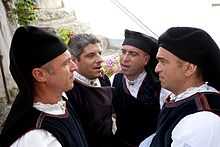Tenores di Bitti "Mialinu Pira"
| Tenores di Bitti "Mialinu Pira" | |
|---|---|
|
Tenores di Bitti "Mialinu Pira" in concert in, 2009 | |
| Background information | |
| Origin | Italia |
| Genres | Canto a tenore |
| Years active | 1995–present |
| Website | tenoresdibitti.com |
| Members |
Omar Bandinu Marco Serra Bachisio Pira Arcangelo Pittudu |
| Past members |
Dino Ruiu Gianfranco Cossellu |
Tenore di Bitti "Mialinu Pira" is a cantu a tenore Italian ensemble formed in 1995. Cantu a tenore is a style of polyphonic folk singing characteristic of the Barbagia region of the island of Sardinia (Italy), even though some other Sardinian sub-regions bear examples of such tradition. The a cantu a tenore was proclaimed by the UNESCO “Masterpieces of the Oral and Intangible Heritage” in 2005.
Biography
The Tenores di Bitti “Mialinu Pira” have a special place among the many groups in Sardinia. Having a style which is slightly less rough than that of other quartets, exemplary researchers in their heritage, impeccable executors with exceptional vocal quality, adorable people, they have reached a level of excellence and of admiration which is without equal in Sardinia and in the whole world. Their frequent performances on so many national television programs are to be remembered. In the last few years they've been touring extensively Europe (France, Germany, Denmark, Norway, Czech Republic, Spain, Belgium, Nederland, Austria, Luxembourg, Slovenia, Swiss, Ireland, Croatia, Serbia, Lithuania, Estonia, Poland, Tunisia, Hungary, United Arab Emirates, Brazil and Japan). It is also remarkable their participation in 2001 to the Christmas Concert in the Vatican for the Pope John Paul II, the concert on May 2009 in the Concertgebouw Theater in Amsterdam and in December in the Church of the Nativity in Bethlehem. The Tenores di Bitti “Mialinu Pira”, having performed for so many years, is nowadays considered from music-fans and etno-musicologists the most prominent example of this vocal art. There are many points that make them so special : the cantu a tenore is still well alive in Sardinia performed by many groups, most of them are old singers performing traditional texts. Their young age is a first approach to notice how their sound, harsh and ancestral, is in fact very homogeneous. Their perfect tuning and their powerful sound is very rare today, because this skill needs years of practice and passion to be performed at its best.
Another matter to be pointed is their accuracy in choosing lyrics. Both in dancing (lestru, dillu, seriu, passu torrau,) and slow (isterrita, boch'e notte) forms, the lyrics, by famous poets or from misknown contemporary authors, make the repertoire of Tenores di Bitti “Mialinu Pira” an important vehicle of literary transmission. These songs are profane poems speaking about the shepherds and their solitude in touch with the nature, referring to the popular world and its traditions. The religious’ songs are performed in church, in particular moments of the liturgical year (Christmas, Easter or patronal feasts) or during the religious processions through the street of the village of Bitti. The Grobbes and some lullabies for Baby Jesus (su Nenneddu) belong to this repertoire.

The "a tenore song"
The Tenores singing (cantu a tenore) is one of the more ancient ways of singing in the Mediterranean area. Nothing about its origins is sure, but the historians maintain that this traditional polyphony goes back to 3000 years ago.... The singing is made a cappella by four male voices (oche, mesu oche, bassu and contra), the main feature of this polyphony is represented by bassu and contra because of their guttural and ancestral sound. The Tenores singing from Bitti, in the centre of Sardinia, is a unique vocal style. It immediately succeeds in sounding primitive and strong. It is no mere coincidence that the experts think that it may have had its origin in primitive times as an imitation of nature: the four voices of which the choir is composed is no more than the lowing of cattle, the bleating of sheep and the sound of the wind. These were harmonised and given poetic lyrics of age-old beauty. The guttural use of voices and the typical songs of intonation, cannot be confused with anything else and make this millenary art have great impact. A magic of the human voice. The a Tenore Song was proclaimed by the Unesco “Masterpieces of the Oral and Intangible Heritage” in 2005.
Members
- Bachisio Pira - Oche e Mesu Oche
- Arcangelo Pittudu - Oche e Mesu Oche
- Omar Bandinu - Bassu
- Marco Serra - Contra
Awards
Discography
- CD “Su Monte ‘e Mesus” recorded and mixed in Rockhouse Blu Studio (Sassari). MC 1998, CD 2000
- CD “Tenores” VOL. 1 compilation recorded and mixed in Live Studio by Marco Luzzu and Giovanni Carlini. Cagliari 2003
- CD “Musica Sacra International” live recording Germany in Martin's church in Kaufbeuren St. (Germany) on 29 May 2004
- CD Highlights of the 51st Cork International Choral Festival 2005 'Ethnic & Other Voices'
- CD e DVD, Orchestra mediterranea, live recording in San Paolo of Brasil on 2005
- CD Ost Soundtrack 'Meine schöne Bescherung'. Colonia (Germania) 2007
- CD Cunzertos (concerts live). TDB Mialinu Pira, Italia 2013
 |
Ballu Seriu starts with single voices (Oche, Bassu, Contra, Mesu Oche)
Tenores di Bitti Mialinu Pira Live recording in Modena, June 2011 |
| Problems playing this file? See media help. | |
%2C_2009.jpg)